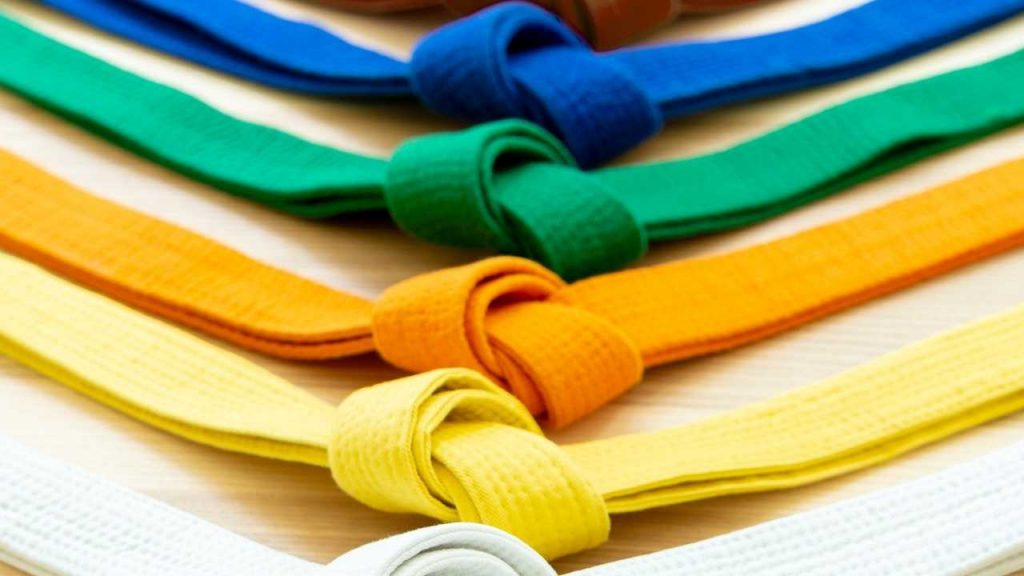Belts are an iconic feature of martial arts, but figuring out what they mean can be confusing. You’ll likely have many questions about the order, how they are earned, and how easy they are to achieve. Thankfully, I’m here to answer all your questions.
Whether you’re a beginner picking your first martial art or an experienced martial artist who is just curious, here is your comprehensive guide to martial arts belts. By the end, you’ll have all the information you need. Let’s get started!
Table of Contents
- What Is the Order of Martial Arts Belts?
- Do All Martial Arts Have Belts?
- The History of Martial Arts Belts
- The Purpose of Martial Arts Belts
- Can Anyone Become a Black Belt?
- Best Martial Art for Getting a Black Belt
- Challenges and Controversies of Martial Arts Belts
- Tips for Advancing Through Belt Ranks
- Beyond Black Belt: Advanced Ranks and Titles
- Martial Arts Belts – FAQs
What Is the Order of Martial Arts Belts?
The order of belt colors in martial arts is similar among all martial arts that use them, with a few exceptions. Certain colors may not be used by all martial arts, and their significance and meaning may vary from style to style.
Most levels of martial arts belts start with lighter colors, getting progressively darker with each increased level. In post-World War 2 Japan, dye and belt materials were scarce and expensive, so it was more cost-effective to keep dying the same belt darker colors.
There are nine colors common among belt color rankings:
White
A white belt is the first belt color assigned to a beginning martial artist. This color marks the student as a novice who has just begun their martial arts training. Depending on the martial art, the white color is said to represent purity, innocence, a new beginning, or a seed beneath a layer of snow.
Yellow
When a student has mastered the basics, they can be awarded a yellow belt. The yellow color represents an open mind, new strength, or sunlight warming a new seed.
Orange
Orange belts are used to represent the highest level, where a student is considered a beginner. Karate, judo, and kung fu have orange belts, but not all taekwondo schools use this color. Orange represents determination, blazing sunlight, and developing strength.
Green
The green belt marks the student’s progression to the intermediate level. In some styles of kung fu, the green level is when the student can start weapons training. The green color signifies growth, change, and the development of a seedling.
Blue
Blue belts are around halfway through a student’s training in most martial arts that use the belt system. At this level, the student focuses more on speed, precision, and mental serenity rather than building strength. Blue is said to symbolize a clear sky, calmness, or patience.
Purple
The purple belt is awarded when a student goes from intermediate to advanced level. In Japanese martial arts, the purple color is said to have been inspired by the sky at dusk and represents deepening knowledge. In kung fu, it represents ambition, confidence, and power. Karate, kung fu, and judo use purple belts, but taekwondo doesn’t always include this color.
Brown
Depending on the martial art, brown belts are usually one or two levels below black belt. Brown represents stability, the Earth, or ripening seeds before the harvest. Karate, kung fu, and judo use brown belts, but taekwondo doesn’t usually award brown belts.
Red
Red belts have more variability between martial arts than the other colors. Some schools award red belts before black, some don’t use them at all, and others assign them at differing places in the ranking.
Certain styles even use it for upper degrees of black belt. In the schools that use it, red is said to symbolize the danger of the techniques the students have learned and the respect that they must be used with.
Black
Black belts are traditionally the highest of the martial art ranks, marking students that have progressed from student level to proficiency in the martial art. Black belts are further divided into ranks (10 in most schools) to show how much mastery they have attained, which is sometimes noted physically on the black belt using colored bands or patches.
The symbolic weight of a black belt varies between martial arts, with some considering it a sign of mastery by itself and others just the beginning of the professional level.
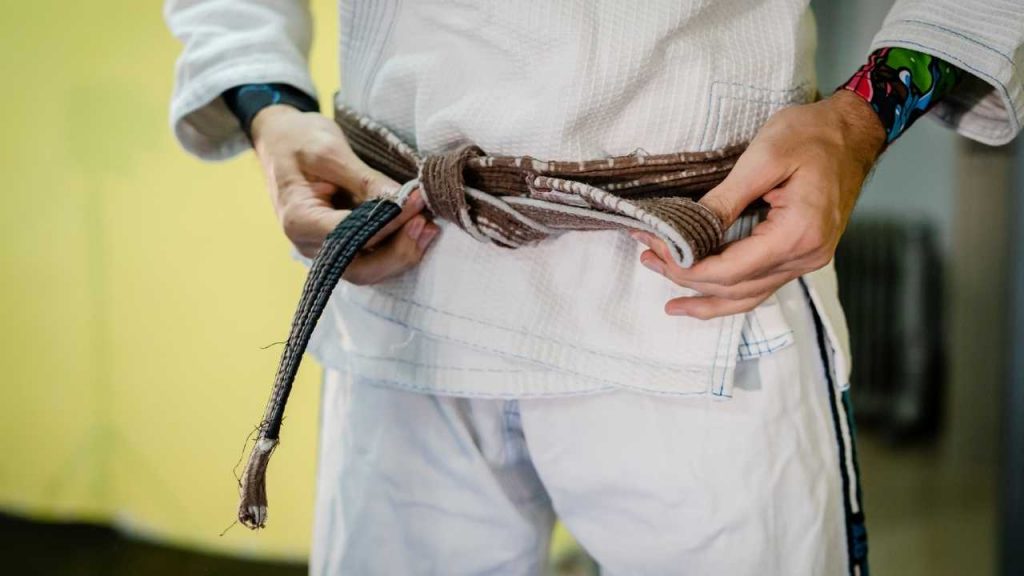
Do All Martial Arts Have Belts?
Belts are a common feature of modern East Asian or Asian-derived martial arts. The practice originated in Japan at the end of the 19th century and was adopted into many Japanese martial arts before spreading to martial arts from other nearby countries, such as Korea’s taekwondo and China’s kung fu.
Today, judo, karate, taekwondo, kung fu, Brazilian jiu-jitsu, Krav Maga, and many other popular martial arts use belts as a way to help students track their progress. Martial arts with Western origins (such as boxing or collegiate wrestling) and some traditional martial arts schools don’t use the belt system.
Martial arts that have heavy cultural significance will usually avoid belt systems as well, as they are seen as foreign influences. For example, Muay Thai in Thailand doesn’t use belts and instead uses fight records and traditional colored Pra Jiad armbands, while a few Muay Thai schools overseas use a modified version of the belt system just for its practical benefits.
Differences Between Belts
The materials used to make the belts themselves vary by martial art. Japanese martial arts, such as karate and judo, use thick cotton belts. Kung fu uses sashes made out of thinner, silky materials. Some martial arts, such as Krav Maga, don’t use physical belts at all and only award the belt color as a certification.
In addition to the physical differences between belts, there can also be variations between the meaning and weight behind a black belt when comparing martial arts to each other.
In some martial arts, earning the black belt means that you’re proficient in that martial art’s techniques but still have learning ahead of you to truly master the martial art. Martial arts that use dan ranking often fall into this category.
In other martial arts, such as Krav Maga, the black belt is the highest level, and it can only be tested for and earned by invitation when your instructor thinks that you’ve really mastered the martial art.
Belt Progression Testing
Belt progression is typically measured by tests. Testing usually requires that a student demonstrate specific techniques, take written exams, win sparring sessions, or do various combinations of the three.
Depending on the martial art and the level being tested for, testing may be offered by the martial arts school itself or by an outside association that oversees that particular martial art. The student must prove that they are mentally and physically ready for the next belt color, and the time frame it takes to progress varies from person to person.
In general, the further along the student is in the ranking system, the more the tests are spaced out. It’s not uncommon for a student to fly through the first few belts relatively quickly before reaching more challenging levels.
How Do Non-Belt Martial Arts Track Progress
In martial arts without belt progression, other systems need to be used to track the progress of students. In combat sports, such as boxing and MMA, progression is usually tracked by the martial artist’s fight record or sparring performance.
Some modern boxing gyms use machines called punch trackers, which are designed to monitor the number and quality of punches in a training session. Some martial arts, such as Russian systema, are more free-form in nature and don’t have a regimented ranking system, instead leaving it to the individual schools to organize the curriculum and decide when students are proficient.
Some martial arts use testing and ranking systems that don’t include the use of belts or color levels, such as some traditional schools of tai chi and kung fu.
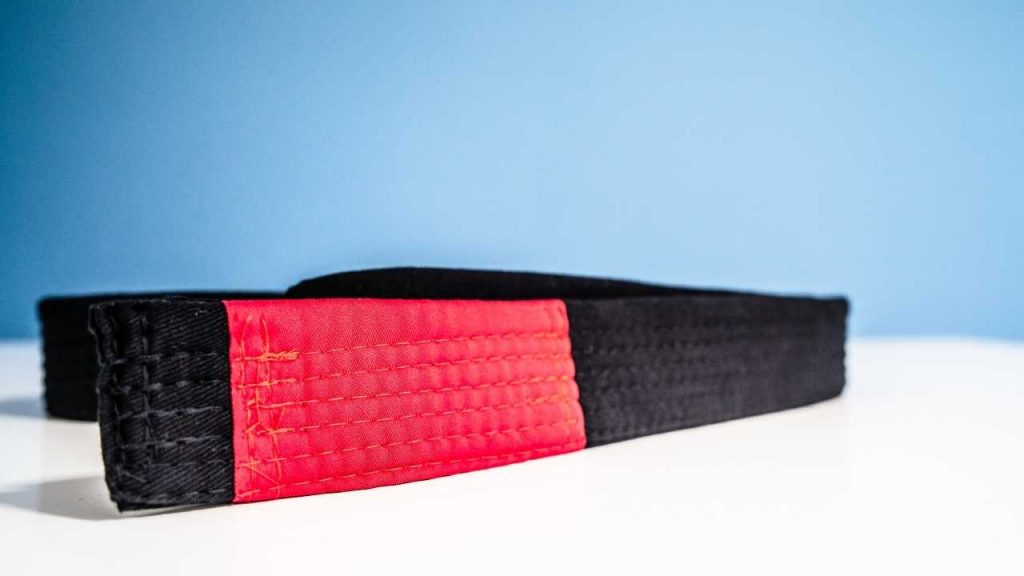
The History of Martial Arts Belts
The origins of the martial arts belt system began in judo, a Japanese martial art and combat sport that specializes in throws. The founder of judo, Kanō Jigorō, designed a ranking system for judo inspired by both the ranking system used in the board game called Go and by belts worn by professional swimmers as a way to measure the skill level of his students.
Go is a competitive strategy board game similar to chess that is popular in Japan and uses a ranking system that divides players into students (Kyū) and masters (Dan) and assigns ranks in each of the categories.
Inspired by this idea, Jigorō originally used black and white belts to denote a judo practitioner as either a beginner or a proficient martial artist. Typically, black belts were reserved for teachers originally.
Over time, this system was expanded to help denote the skill levels of the students who were previously all ranked with white belts. Gunji Koizumi, the founder of the British Judo Association, and Mikinosuke Kawaishi, a judo master teaching in 20th century France, introduced more colors to the belt system as a way to encourage and incentivize their students at the kyu/student levels of training.
In addition to this, different ranks were added to the final black belt, resulting in a total of 10 dan ranks that a judo black belt can earn.
The Spread to Other Martial Arts
The next martial art to adopt the practice of colored belts was karate. Gichin Funakoshi, the founder of Shotokan Karate, was considered the Father of Modern Karate, as well as someone who provided many memorable quotes.
He encountered the belt system while studying judo under Jigoro Kano. He recognized the system’s utility as a martial arts training tool and adopted it into the Okinawan Karate style he was developing and trying to popularize on the mainland in Japan.
Some traditionalists were heavily opposed to the belt system and other modern modifications that Funakoshi brought to karate, and he wasn’t able to return to his native Okinawa for many years because of the backlash. Others embraced the changes, and Shotokan Karate became the most popular and common style of karate in the world.
From karate, the belt system moved to taekwondo. During the Japanese occupation of Korea, many boys were sent overseas to Japan to be educated. Through this, they encountered karate, judo, and the belt system.
When they returned to their home country and began to develop and standardize taekwondo in the 1950s, the belt system was one of the influences from karate that they chose to retain. Choi Hong-hi, one of the early founders and promoters of taekwondo, had studied Shotokan Karate under Gichin Funakoshi.
As these martial arts grew in popularity and spread worldwide, so did the belt system. Some modern schools of kung fu use a modified version of the belt system, using unique-looking sashes rather than the thick cotton belts popular in other martial arts.
Krav Maga saw the utility in the belt system and adopted the ranking style without using physical belts that might be a hindrance to their practical self-defense techniques.
Martial Art Belt Myths
Over the years, some myths have been associated with the martial art belt system. One common story is that the origin of the black belt is that martial artist wouldn’t ever wash their belts and that they would get darker with use over the years, eventually turning black.
Another myth is that the belt system was designed to keep lazy Americans or Europeans (depending on who is telling the story) engaged and interested in martial arts.
The Purpose of Martial Arts Belts
Martial arts belts were originally designed to be a physical representation of the skill level that the martial artist had achieved. Today, they are used as concrete goals as the student progresses through their martial arts training.
Having a clear purpose in mind can help motivate students to push past their perceived limits in pursuit of achievable milestones. This can be especially useful for youth classes, where kids can easily become discouraged or lose interest without being able to see their progress or receive external validation, but the benefits can carry over just as well to adult classes.
The belt system helps students facilitate skill progression by breaking down the martial arts into parts and giving the students a way to feel a sense of accomplishment as they master new skills. Often, while learning a new skill, students can reach a plateau where they feel like they’re stuck and not making progress.
By splitting the martial arts up into many different belt levels, this plateau can mitigated, as there is always a new goal or level close by. Each belt offers a reachable nearby goal that the student can strive for easier than a distant goal of martial arts mastery. The skills required by each belt are built on each other and organize learning into a more structured system than learning individual techniques out of order.
The belt system can also offer a kind of camaraderie among students and encourage them to practice among their peers. This sense of community can also promote advanced students helping those at lower belt levels. The belt system can help foster a more encouraging environment rather than a competitive one.
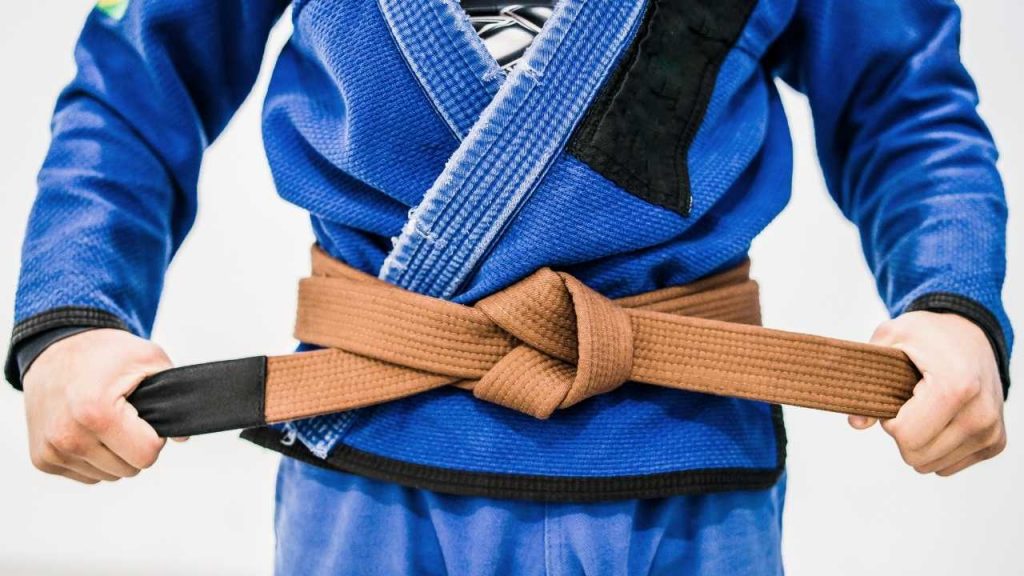
Can Anyone Become a Black Belt?
Everyone has the opportunity to earn the highest belts in martial arts, but whether or not you can reach that goal depends on your skill and dedication to training. Achieving a black belt takes years of hard work and training, which not everyone is willing to devote to martial arts.
How Difficult Is It to Become A Black Belt
Earning a black belt takes years of dedicated practice and training in your martial art of choice. It isn’t easy, but it is also not unachievable so long as students take steps one at a time in their martial arts journey.
Each kyu belt earned prior to the black belt will build your skills and make you better prepared for the black belt test. However, if you don’t practice or attend classes regularly, earning a black belt can be nearly impossible.
How Long Does It Take
The length of time it takes to earn a black belt depends on the martial art, your aptitude, how often you practice, and how your particular school operates. Some martial arts, such as Brazilian jiu-jitsu, can take ten years to reach the status of black belt.
Others, such as aikido or taekwondo, can be earned in as little as three years. If you have a natural aptitude or talent for your particular martial art, you may progress through the earlier belts faster than average, especially if you apply yourself and practice hard. If you have an injury or illness, it may slow your progress down.
It’s also important to know what exactly your school requires to progress to the next belt level so that you can make sure you’re studying appropriately for the belt tests.
Who Can Become a Black Belt
Anyone who can physically perform martial arts and has the dedication to study and practice has the potential to earn a black belt.
Individual aptitude, strengths, and weaknesses can vary, so each path to the black belt is different for every martial artist. Some may reach the black belt sooner than others, while others may take the slow and steady pace.
Best Martial Art for Getting a Black Belt
Earning a black belt is a great goal and achievement, but it’s a point along the journey rather than an end goal. The best martial art for earning a black belt depends on your interests, goals, and dedication.
The Fastest Black Belt
Taekwondo is one of the fastest martial arts in which a student can earn a black belt, with the average time it takes to earn one at around three years of consistent practice to reach the 1st dan of the black belt.
When trying to find a school that awards belts quickly, it is important to make sure that the school is legitimate, as unscrupulous schools will sometimes award belts too quickly.
The Longest Black Belt
Brazilian jiu-jitsu is one of the martial arts that takes longer to earn a black belt. The reason for this is that the progression test to earn a new belt includes sparring sessions, which force the students to prove their skills on the mat to proceed to the next level. A black belt in Brazilian jiu-jitsu often takes over a decade to earn.
Best Black Belt for Self-Defense
Krav Maga is a deadly martial art with an intense focus on self-defense that uses the belt system. Unlike many other martial arts, Krav Maga students don’t wear physical belts but instead earn the belt colors as certifications as they pass tests that prove their growing skill.
The black belt in Krav Maga is awarded by invitation only after the student has mastered this martial art’s brutal techniques and no-mercy fighting spirit.
Best Black Belt for Competition
Judo is a highly competitive combat sport and martial art that uses the belt system. Judo competitions are common and widespread all over the world and have even been added to the Olympic Games, making it a great option for competitive martial artists. A black belt in Judo typically takes around five years to earn.
Best Overall Black Belt
Karate is a martial art that uses the belt system with enough variations and flexibility to suit any need. There are schools that focus on character building, others that focus on competitions, some that teach self-defense, and others that blend those goals together.
After you go through the order of karate belt colors, reaching the 1st dan of a Karate black belt usually takes around four years. However, attaining the highest dan can offer a lifetime of training and development.
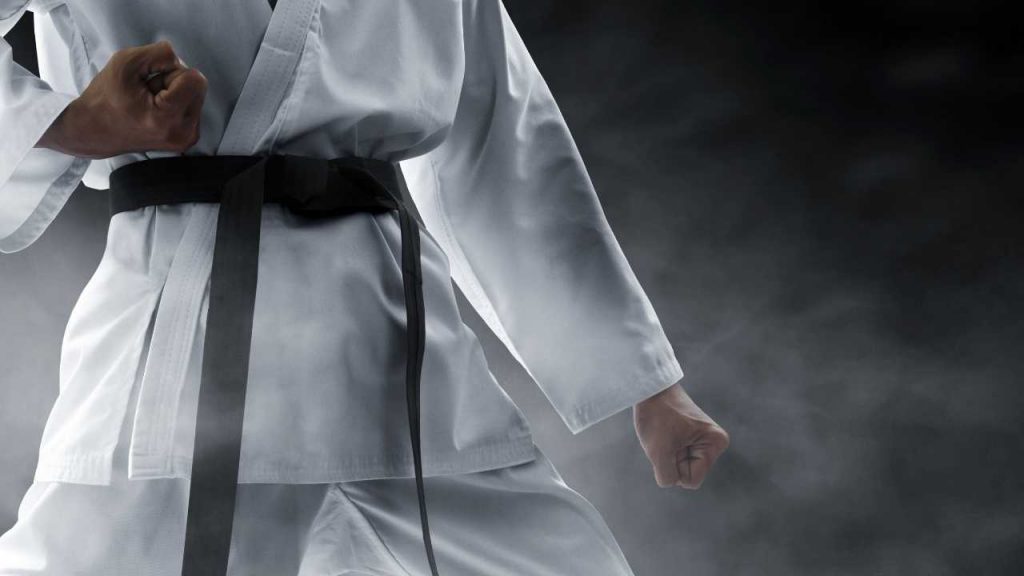
Challenges and Controversies of Martial Arts Belts
While the martial art belt system has many good points, it isn’t without controversy. The system can be monetized by unscrupulous teachers. The growing number of black belts can make it seem less valuable. Some traditional forms of martial arts can find it too modern or gimmicky.
McDojos
McDojos is a combination of the words “McDonald” and “dojo” in reference to the global fast-food chain. It means a cheap and fast dojo of low quality that only exists to earn a profit. A McDojo will water down and simplify techniques to increase the number of students who can perform them instead of teaching their students to grow and improve to meet the challenge.
They often guarantee belt progression in time frames or for a cost, regardless of whether or not the student is ready. McDojos can seem like an easy way to earn a black belt, but because of the sub-par teaching, it can give students a skewed idea of where their current skill level really is.
It can also put students studying for self-defense in danger by making them overconfident and under-prepared for real fights.
Belt Inflation
Belt inflation occurs when the high number of black belts lowers their perceived value in a way that resembles a college degree or monetary inflation. This issue often goes hand-in-hand with McDojos, who have a reputation for selling black belts to anyone who pays them enough or by seeing little kids earning black belts and considering it a participation trophy.
However, reputable schools can encounter this problem as well, especially if there is a misunderstanding of the meaning of the black belt. Schools that use first-degree black belts as a sign of proficiency rather than mastery might look like a case of belt inflation if someone doesn’t understand the school’s philosophy.
Black Belt Legitimacy
Not all martial arts use the belt system. The practice started in the 19th century, so older or more traditional schools may not view a black belt as a legitimate sign of mastery. It can be seen as a modern marketing gimmick, especially by more old-school martial artists.
The proliferation of McDojos and their loose requirements for belt progression can also make people wonder if a black belt is really a sign of a trained martial artist or just a sign that someone signed up for a class.
Many people see children earning black belts and question if it really means anything at all. Whatever the reason someone may question the legitimacy of a black belt, what really matters in the end is what it means to the martial artist earning it.
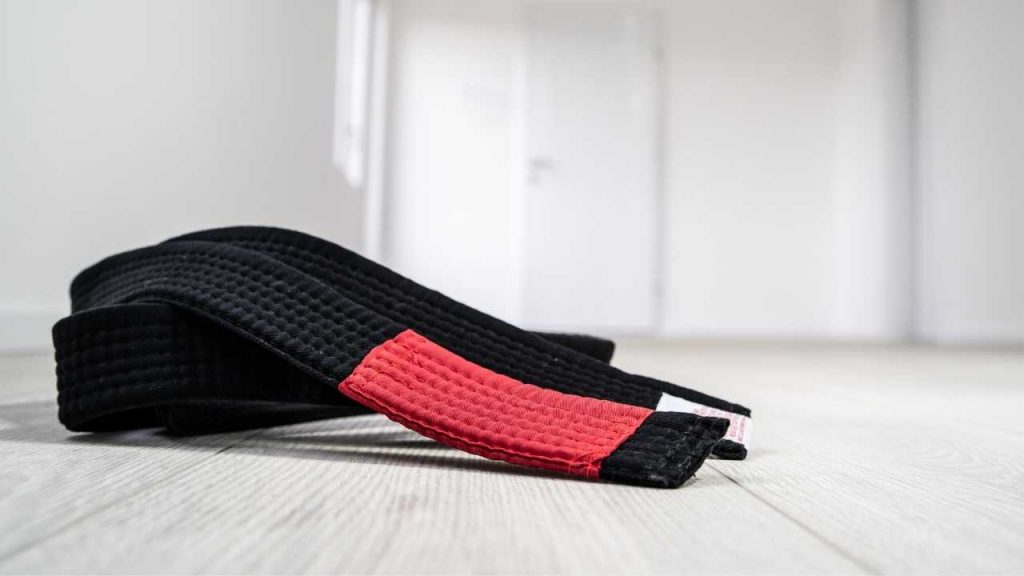
Tips for Advancing Through Belt Ranks
Practice makes perfect, and the more consistent you are in your training, the easier it will be to progress through all the belt ranks. If you’re working your way up the belt ranks, there are a couple of things you can do to speed up your progress.
Practice At Home
Practicing at home when you have free time can help you master the techniques required for the belt test faster. Even just a few minutes every day can go a long way to improving your strength and posture and can help you commit the techniques to muscle memory.
Attend Classes Regularly
Practicing at home has its uses, but attending class is even more critical to progressing through the belt ranks. Attending classes not only allows you to learn new techniques but also allows you an opportunity to be corrected if you’re doing something wrong.
Group classes are useful because you can observe how other students perform while practicing yourself. Personal training can help you refine the way you do things and fine-tune your techniques.
Set Realistic Goals
Make sure the goals that you’re aiming for are realistic. If you’re over-ambitious, you can be setting yourself up for failure or disappointment if you don’t achieve a goal that wasn’t ever really possible. Talking to more advanced students or instructors can help you determine if your goals are realistic or if they should be adjusted.
Seek Feedback
Asking for feedback from your instructor or from more advanced students can help you narrow down and iron out problems you might be having during training. Practicing a technique wrong can be a way to form a bad habit, and it might be easier to notice from an outside perspective. Asking for feedback can also be a chance to practice humility, which is a good mindset to have while studying martial arts.
Live a Healthy Lifestyle
Living a healthy lifestyle can improve your martial arts experience and help speed up your climb through the ranks. Maintaining a healthy weight can improve your stamina and lower your risk of injuries that could slow you down.
Eating a wholesome diet and maintaining a good sleep schedule can help you recover from workouts faster and allow you to practice more without wearing yourself out. Practicing strength training or cardio exercises in addition to martial arts training can help improve your strength and stamina for martial arts techniques.
Mental Preparation for Tests
Tests can be a nerve-wracking experience. It’s normal to get nervous or flustered during any kind of test, and belt progression tests are no different. Visualizing the test and positive outcomes in the days leading up to the test is a training technique that helps quiet worries over making mistakes.
If you do make a mistake or fail a test, remember that it’s only a test to determine your current skill level, not your overall potential. You may just need to practice more and try again.
Beyond Black Belt: Advanced Ranks and Titles
Earning a black belt isn’t the end of a martial artist’s journey, but just a new beginning. In many martial arts, black belts are divided into ranks. The number of ranks typically ranges from 5-10, depending on the exact martial art.
These upper ranks are called dan ranks, as opposed to the kyu ranks used for pre-black belt students. In addition to ranks, there are also titles that martial artists can earn at the black belt level. Teaching or taking a leadership role in the school is a common way to earn a title. Teaching is also a great way to further deepen your own skills and understanding of the martial art while helping others.
Karate Titles
Karate assigns certain titles and honorifics at different black belt ranks:
Yudansha is a title that refers to a blackbelt of any rank. This title is shared with judo practitioners.
Lower-ranking students call 1st or second-dan black belts “Senpai” to acknowledge their seniority. At 3rd or 4th dan, or if the black belt starts teaching, the honorific is changed to “Sensei.” However, it’s considered rude or improper to introduce yourself with either honorific.
Shihan is the title for senior teachers who are no longer considered students and aren’t normally assigned to ranks lower than 4th dan. Shihan is also used as a title in judo.
Renshi is the next title and stands for a polished expert. Renshi isn’t specifically tied to any exact Dan rank but isn’t normally earned any lower than 6th Dan.
Kyoshi is the next highest title and means “Teacher of Teachers.” It’s earned by black belts who have been teaching long enough that their students have gone on to teach as well, and is typically earned at 7th or 8th dan.
Hanshi is the highest title, which is usually earned after decades of experience, or at 9th or 10th dan. Hanshi carries a weight similar to the title “Professor.”
Taekwondo Titles
Taekwondo assigns certain titles at dan ranks:
Boosabeom roughly translates to “junior instructor” and is often used around the 1-3 dan ranks.
Sabeom or sabeomnim is an honorific that roughly translates to “coach.” It is a sign of respect and is usually earned around the 4-6 dan rank.
Sahyeon is a title earned at 7 or 8 dan.
Finally, at the 10th dan, martial artists can earn the title Saseong, which is equivalent to “Grandmaster” in some other martial arts.
Kung Fu Titles
Titles in Kung Fu aren’t always tied to belt colors. The Wushu Duan Wei System is one system used internationally to evaluate and rank kung fu and tai chi practitioners.
Many of these ranks have age restrictions as well as conventional testing requirements. This system divides practitioners into four categories, with each containing three levels:
Pre-Duan Wei is the category used by recreational martial artists.
Elementary Duan Wei focuses on study and acquisition of practical skills and techniques.
Intermediate Duan Wei is earned when the martial artist begins to teach.
Advanced Duan Wei is reserved for martial artists who have high levels of academic knowledge of their martial arts and who promote martial arts and values.
Master
The title “Master” is used in some karate schools, especially in English-speaking countries. It is associated with 5th dan and may require certification and testing from official organizations to be considered valid.
Grandmaster
Grandmaster is a title associated with the founder of a school or the head of a style, who has shown not only great skill in martial arts techniques but also leadership and teaching skills. “Soke” is sometimes used interchangeably with “Grandmaster” in Japanese-speaking schools.
In taekwondo, the title “Grandmaster” is associated with 9th-degree black belts, and is assigned by a taekwondo association. In kung fu, “Sigung,” “Sitaigung,” and “Sijo” are titles that roughly correspond with “Grandmaster” and factor in seniority as well as skill level and leadership roles.
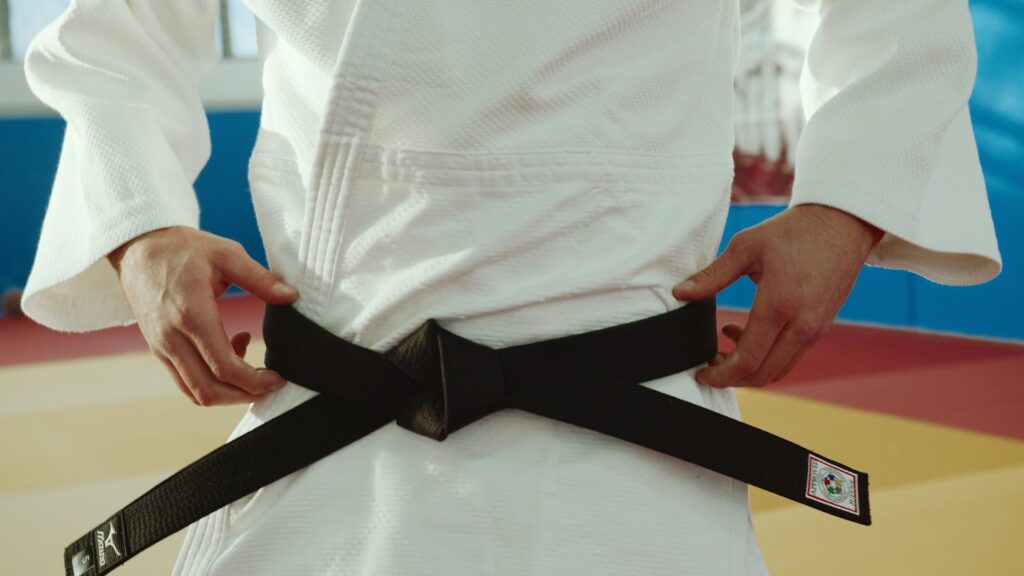
Martial Arts Belts – FAQs
What are the levels of black belt?
There are usually ten levels of black belt. These levels are called dan ranks and are sometimes accompanied by colored bands on the black belt itself.
Not every martial art uses this ranking system, and it is most commonly seen in Japanese martial arts and global martial arts that have been influenced by Japanese martial arts (such as Brazilian jiu-jitsu and taekwondo). Others, such as Krav Maga, simply stop at the level of black belt.
Is red belt higher than black belt?
Not usually. The meaning of a red belt varies depending on which martial art is using it. In some martial arts, such as taekwondo, the red belt comes before the black belt. In some styles of Karate, an embroidered red belt can denote a grand master or the founder of a school.
Certain schools of karate use a red colored belt to represent the three highest dans of a black belt, although it is counter-intuitively still called a black belt. In jiu-jitsu, red bands are added to black belts to demonstrate what level of black belt the martial artist has earned.
What’s higher than a black belt?
Black belts can include ranks that indicate the skill level of the martial artist. These ranks are numbered in ascending order and are sometimes accompanied by colored bands or other additions to the black belt.
For example, a 5th dan black belt is higher than a 2nd dan black belt. Some martial arts also assign the title of “Master” to black belts who meet certain criteria, such as teaching experience or years of continued practice after earning the black belt.
The highest position of all is “Grandmaster,” which is usually reserved for the founder of a school or other similar prestigious position.
How many belts are there in Karate?
There are nine different belt colors used in Karate, eight kyu (or student) belts, and a final black belt. The belts serve as a physical representation of the skills that the student has learned. The final black belt is further divided into ten degrees to show different levels of mastery, with the upper dan ranks taking a lifetime of dedication and training to earn.
Is there a mixed martial arts belt order?
Most MMA gyms don’t use a belt ranking system, although individual martial arts used in MMA may do, such as Brazilian jiu-jitsu. Like boxing, MMA gyms tend to use fight records to track the progress of their students.
However, the International Mixed Martial Arts Federation recently introduced a belt ranking system as a way to keep recreational MMA students engaged and give them a way to measure their progress. The ranking system was only introduced in 2022 and hasn’t seen widespread adoption by many MMA gyms yet.


